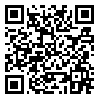1. Afshari Z, Rakhshani M. Factors related to mental health of students in Zabol University of Medical Sciences. J Neyshabur Univ Med Sci. 2014;2(3):28–36. [Persian] [
Article]
2. Besharat MA, Masoodi M, Gholamali Lavasani M. Alexithymia and psychological and physical vulnerability. Thoughts and Behavior in Clinical Psychology. 2015;9(34):47–56. [Persian] [
Article]
3. Garmezy N, Rutter M. Stress, Coping, and Development in Children. Baltimore, US: Johns Hopkins University Press; 1983.
4. World Health Organization. Risks to mental health: an overview of vulnerabilities and risk factors [Internet]. Background paper by WHO secretariat for the development of a comprehensive mental health action plan; 2012, pp: 1–14. Available from: [
Article]
5. Que J, Lu L, Shi L. Development and challenges of mental health in China. Gen Psych. 2019;32(1):e100053. [
DOI]
6. Formánek T, Kagström A, Cermakova P, Csémy L, Mladá K, Winkler P. Prevalence of mental disorders and associated disability: Results from the cross-sectional CZEch mental health Study (CZEMS). Eur Psychiatry. 2019;60:1–6. [
DOI]
7. Zarei E, Mirzaei M, Sadeghifard M. Providing a model to determine the role of communication skills and problem solving skills in preventing from mental and social damages by mediated family conflicts. Counseling Culture and Psycotherapy. 2018;9(35):1–26. [Persian] [
DOI]
8. Karimi M, Donyavi V, Rah Nejat AM, Kiani Moghaddam AS. Relationship spirituality with loving style and couple’s communication pattern. Nurse and Physician Within War. 2017;5(15):44–52. [Persian] [
Article]
9. Esmaeilpour Kh, Khajeh V, Mahdavi N. Predicting couples’ marital satisfaction based on relationship beliefs and relationship skills. Journal of Family Research. 2014;9(1):29–44. [Persian] [
Article]
10. Amstad FT, Meier LL, Fasel U, Elfering A, Semmer NK. A meta-analysis of work-family conflict and various outcomes with a special emphasis on cross-domain versus matching-domain relations. J Occup Health Psychol. 2011;16(2):151–69. [
DOI]
11. Javidi N, Soleymani A, Ahmadi K, Samadzadeh M. The effectiveness of Emotionally Focused Couples Therapy (EFT) to improve communication patterns in couples. Journal of Research in Behavioural Sciences. 2013;11(5):402–10. [Persian] [
Article]
12. Fatehizadeh, M, Ahmadi. The relationship between marital satisfaction and communication patterns of couples in Isfahan university. Journal of Family Research. 2005;1(2):109–19. [Persian] [
Article]
13. Christensen A, Shenk JL. Communication, conflict, and psychological distance in nondistressed, clinic, and divorcing couples. J Consult Clin Psychol. 1991;59(3):458–63. [
DOI]
14. Bidram M. Rabete beyn olgou-haye ertebati va vijegi-haye shakhsiyati zojeyn ba sazegari zanashouie va rezayat zanashouie [The Relationship between communication patterns and couples’ characteristics with marital adjustment and marital satisfaction] [Thesis for M.Sc. in Family Counseling]. [Kerman, Iran]: Shahid Bahonar University;2014, p:5. [Persian]
15. Zarepour M, Asoode MH. Salamat ravan zojeyn: naghsh ab’ade samimiat zanashouie va olgouhaye ertebati [Couples mental health: the role of marital intimacy dimensions and communication patterns]. In: Second National Conference on Family Psychology [Internet]. Marvdasht, Iran: Islamic Azad University of Marvdasht; 2014. [Persian] [
Article]
16. Bahrami M, Nazari AM, ZAhra Kar K. Prediction of couple’s communication patterns by spiritual health and psychological well-being. Thoughts and Behavior in Clinical Psychology. 2014;9(33):7–16. [Persian] [
Article]
17. Gilbert P, Allan S, Goss K. Parental representations, shame, interpersonal problems, and vulnerability to psychopathology. Clinical Psychology & Psychotherapy. 1996;3(1):23–34. [
DOI]
18. Noorbala AA, Faghihzadeh S, Kamali K, Bagheri Yazdi SA, Hajebi A, Mousavi MT, et al. Mental health survey of the Iranian adult population in 2015. Arch Iran Med. 2017;20(3):128–34.
19. Green SB. How Many subjects does it take to do a regression analysis. Multivariate Behav Res. 1991;26(3):499–510. [
Article]
20. Derogatis LR, Rickels K, Rock AF. The SCL-90 and the MMPI: a step in the validation of a new self-report scale. Br J Psychiatry. 1976;128:280–9. [
DOI]
21. Fathi Ashtiani A, Dastani M. Psychological Tests: personality and mental health. Tehran: Be’sat Pub;2009, pp:291–304. [Persian]
22. Modabernia MJ, Shojaie Tehranie H, Falahi M, Faghirpour M. Normalizing SCL-90-R inventory in guilan high-school students. J Guilan Uni Med Sci. 2010;19(75):58–65. [Persian] [
Article]
23. Christensen A, Sullaway M. Communication patterns questionnaire. Unpublished questionnaire. University of California, Los Angeles; 1984.
24. Ebadatpoor B. Hanjaryabi porsesh-name olgouhaye ertebati zanashouie dar shahr Tehran dar sale 78–79 [Standardization of Marital Relationship Pattern Questionnaire in Tehran, 1999-2000] [Thesis for M.Sc. in Educational Science]. [Tehran, Iran]:Tarbiat Moallem University; 2000, pp:52–73. [Persian]
25. Heavey CL, Larson BM, Zumtobel DC, Christensen A. The communication patterns questionnaire: the reliability and validity of a constructive communication subscale. Journal of Marriage and the Family. 1996;58(3):796–800. [
DOI]
26. Klever P. Goal direction and effectiveness, emotional maturity, and nuclear family functioning. J Marital Fam Ther. 2009;35(3):308–24. [
DOI]
27. Eldridge KA, Sevier M, Jones J, Atkins DC, Christensen A. Demand-withdraw communication in severely distressed, moderately distressed, and nondistressed couples: rigidity and polarity during relationship and personal problem discussions. J Fam Psychol. 2007;21(2):218–26. [
DOI]
28. Rezaeian H, Massumy S, Hosseinian S. The study and comparison self-differentiation, communication patterns, and sexual satisfaction in divorce-seeking and normal couples. Journal of Applied Counseling. 2018;7(2):17–32. [Persian] [
DOI]
29. Niszczota P. Neuroticism, Uncertainty, and Foreign Investment [Internet]. Rochester, NY: Social Science Research Network; 2014. Report No.: ID 2431188. Available from: [
Article]
30. Ghasemi N, Kajbaf M-B, Rabiei M. The effectiveness of Quality Of Life Therapy (QOLT) on Subjective Well–Being (SWB) and mental health. J Cli Psy. 2011;3(2):23–34. [Persian] [
DOI]
31. Baradaran Eftekhari M, Forouzan AS, Mirabzadeh A, Dejman M, Yousefi H. Maintaining and promoting techniques for mental health used by Iranian married women: a qualitative study. Iranian Journal of Psychiatry and Clinical Psychology. 2018;24(1):70–9. [Persian] [
DOI]
32. Hajebi A, Khoshdel H, NaserBakht M, Khanmohamadi A. The relationship between social support and marital adjustment and mental health of women in a government organization. Journal of Medicine and Cultivation. 2017;25(4):247–56. [Persian] [
Article]
33. Gottman JM. The roles of conflict engagement, escalation, and avoidance in marital interaction: a longitudinal view of five types of couples. J Consult Clin Psychol. 1993;61(1):6–15. [
DOI]






